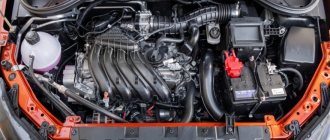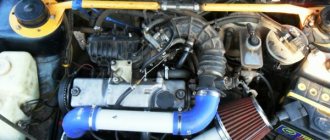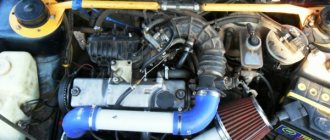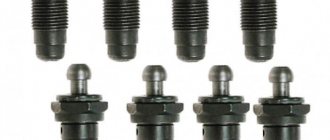Today you can find various types of internal combustion engines on cars, ranging from low-volume 3-cylinder units to powerful V8 or V12. At the same time, the vast majority of cars under the hood have conventional 4-cylinder engines.
If previously such power units were installed on entry-level and middle-class models, now the 4-cylinder engine can be seen even in the premium segment.
The fact is that boosting, increasing the number of valves per cylinder, introducing variable valve timing systems, installing turbocharging and other improvements made it possible to achieve the required power and efficient output from such engines.
The most affordable solution for increasing efficiency turned out to be a design that involves a greater number of valves per cylinder. In the simplest version, engines can have 2 valves (intake and exhaust). In more technologically advanced versions, the timing belt receives 4 or 5 valves.
In this article we will talk about the difference between an 8 valve and a 16 valve engine, as well as which engine is better, 8 or 16 valve. Next, we will try to figure out what advantages and disadvantages a larger or smaller number of valves in an engine has, taking into account the repair and maintenance of such internal combustion engines.
8 valve engine design
Such engines are used mainly on models in the entry-level price segment. Here there are 2 valves per cylinder: 1 for intake and 1 for exhaust.
Another important feature of such power plants is that only 1 camshaft is needed, which controls the gasoline injection and exhaust gas exhaust system. To operate it, a simple belt or chain mechanism is sufficient. Such a system is much easier to maintain and repair compared to complex timing belts of more expensive cars. And such an elementary design significantly affects the final cost of the car.
As an example, we give a diagram of the design of an 8-valve VAZ-2114 engine.
1) generator drive pulley; 2) oil pump; 3) timing belt; 4) coolant pump timing belt; 5) front cover of the timing mechanism drive; 6) tension roller; 7) camshaft toothed pulley; camshaft drive rear cover; 9) camshaft oil seal; 10) cylinder head cover; 11) camshaft; 12) front camshaft bearing cover;
2) oil pump; 3) timing belt; 4) coolant pump timing belt; 5) front cover of the timing mechanism drive; 6) tension roller; 7) camshaft toothed pulley; camshaft drive rear cover; 9) camshaft oil seal; 10) cylinder head cover; 11) camshaft; 12) front camshaft bearing cover;
13) pusher; 14) valve guide; 15) oil separator mesh for the crankcase ventilation system; 16) exhaust valve; 17) inlet valve; 18) rear camshaft bearing cover; 19) fuel pump; 20) housing of auxiliary units; 21) ignition distributor sensor; 22) cooling jacket outlet pipe; 23) cylinder head; 24) spark plug; 25) crankcase ventilation hose;
26) flywheel; 26) flywheel; 27) crankshaft rear oil seal holder; 28) rear crankshaft oil seal; 29) cylinder block; 30) oil pan; 31) oil level indicator (oil dipstick); 32) crankshaft; 33) piston; 34) connecting rod cover; 35) connecting rod; 36) crankshaft main bearing cover; 37) front crankshaft oil seal; 38) crankshaft toothed pulley.
A look at engines from the perspective of safety and efficiency
Many car owners claim that 8-valve engines are safer than their 16-valve counterparts. This is explained by the consequences of a broken timing belt. The improved design of the piston group of the 16-valve 1.8-liter engine, which is installed on modern VAZ, Kalina, Renault and other brands, eliminates this drawback.
Due to fuel injection and combustion waste removal through two valves, it ensures uniform distribution and combustion of the mixture. Because of this, the operation of the 16-valve engine is smooth and economical. At the same time, the technological design of the unit requires expensive professional maintenance.
Advice. Residents of remote areas are better off purchasing 8-valve engines due to their ease of maintenance and repair.
Each car enthusiast must choose for himself which engine is right for him. In this matter, you need to rely on your driving style, financial condition, and maintainability of the installation. Also an important aspect are reviews from consumers and professionals.
Pros and cons of an 8 valve engine
This engine design, despite its venerable age, has many advantages:
- simplicity of design - an 8-valve engine has significantly fewer wearing parts, and accordingly, its repair will be easier and cheaper;
- lack of hydraulic compensators - motors of this type simply do not need them, so the design is further simplified and cheaper;
- less demanding on oil characteristics - 8-valve engines allow the use of lower quality lubricant, which is noticeably cheaper;
- less sensitivity to the quality of gasoline - most of the 8-valve valves used today were developed at a time when there was no better fuel than 92;
- small size - one camshaft takes up much less space, so such engines are more compact than their 16-valve counterparts, and this makes access to attachments easier.
However, there are also many significant disadvantages:
- less power - intake and exhaust through 2 valves significantly limits the amount of fuel supplied to the cylinders and the total engine power;
- slightly higher fuel consumption - the reduced throughput of 1 pair of valves forces the engine to put more effort into pushing exhaust gases into the manifold, and accordingly more energy is spent on this;
- noise at high speeds - the pushers wear out during engine operation, gaps form, which is why the engine begins to make noticeable noise;
- the need for more frequent valve adjustments - if this is ignored, engine performance will drop, and fuel consumption, on the contrary, will increase.
Main differences.
The 8-valve engine has a narrow cylinder head because it has a single camshaft. The candles are located on the block horizontally and at a certain angle. The camshaft controls the order of their opening - first it opens the intake, then the exhaust. The valve opens with the help of conical parts located on the camshaft, and closes with the help of springs located on it. In a four-cylinder engine, there are two valves for each cylinder of the engine - intake and exhaust. Actually, that’s why there are eight of them per power unit.
Advantages of an 8-valve engine:
- Initially, the design of the engine is relatively very simple and, accordingly, easy to maintain.
- The absence of hydraulic compensators undoubtedly simplifies the design of the power plant as a whole.
- Undemanding to oil.
Flaws:
- Power is less compared to a 16 valve engine. It is also impossible to achieve such high speeds - two valves per cylinder does not allow speeding up the intake and release of fuel and gases from the chamber. The process is happening slower than we would like.
- Increased fuel consumption. Due to the fact that the gas exits through one valve, which cannot let through more than it should.
- Such engines are, in essence, noisier, especially when moving at high speeds.
- The absence of hydraulic compensators requires adjustment of the valves as their precise synchronization is disrupted (even with slight deformation of the camshaft cam profile), in the worst case, a knocking sound appears.
16-valve engine and its significant advantages:
- More powerful. It accelerates better and therefore the top speed will be significantly higher than that of an 8-valve engine. More powerful. Accelerates better and therefore the top speed will be significantly higher than the 8-valve engine.
- It is also important that fuel consumption is noticeably less (should be).
- Engine noise is less.
- The valves are regulated by hydraulic compensators.
Flaws:
- The presence of hydraulic compensators requires a timely change of engine oil to avoid coking of the hydraulic compensators.
- Engine maintenance is more expensive. After all, the design of such an engine is an order of magnitude more complex than the design of an 8-valve engine.
A few words about another reason why valves should sit tightly in the seat. In addition to ensuring complete sealing of the combustion chamber, it should be taken into account that the valve discs operate under severe conditions of high heat. In addition, the plates must be in close contact with the seat, which is located on the cylinder head, which is cooled. After all, the heated plate transfers most of the heat to the saddle. This is especially true for the exhaust valve, since it is cooled only through the tight fit of the plate to the seat, and the intake valve is cooled when the incoming air-fuel mixture is in contact with the seat. If there is poor contact with the seat, no (even the most heat-resistant) valve will withstand such strong overheating. It will simply burn out and collapse, so its tight fit in the saddle is very important. Therefore, they are made from heat-resistant metal alloys. In addition, they do not have magnetic properties.
16 valve engine design
In such 4-cylinder engines, each cylinder already has 2 pairs of intake and exhaust valves. To operate such a system, 2 camshafts are required. And for their coordinated work, a much more complex gas distribution mechanism is used. At the same time, 2 intake valves allow more fuel to be supplied to the cylinders per stroke - and hence a significant increase in power and efficiency. At the same time, fuel consumption is reduced thanks to the presence of 2 exhaust valves.
Hydraulic compensators are often used to press the valves against the shaft in such engines. Unlike 8-valve valves with mechanical pushrods, this system operates smoother and quieter. It also provides an additional increase in power and additional fuel economy.
Another specific feature of 16-valve engines, which becomes especially relevant against the backdrop of ever-tightening environmental requirements, such engines, due to more precise operation of the gas distribution mechanism, are safer for the environment.
For example, here is a diagram of the design of a 16 valve VAZ 2112 engine.
1) engine oil pan; 2) front crankshaft oil seal; 3) crankshaft; 4) crankshaft pulley; 5) oil pump; 6) generator drive pulley; 7) timing belt; front cover of the timing mechanism drive; 9) coolant pump pulley (pump); 10) tension roller; 11) camshaft toothed pulley; 12) rear cover of the timing mechanism drive; 13) camshaft oil seal;
2) front crankshaft oil seal; 3) crankshaft; 4) crankshaft pulley; 5) oil pump; 6) generator drive pulley; 7) timing belt; front cover of the timing mechanism drive; 9) coolant pump pulley (pump); 10) tension roller; 11) camshaft toothed pulley; 12) rear cover of the timing mechanism drive; 13) camshaft oil seal;
14) exhaust camshaft; 15) hydraulic pusher; 16) valve spring; 17) valve guide; 18) exhaust valve; 19) receiver; 20) camshaft bearing cover; 21) guide pipe; 22) cylinder head cover; 23) plastic cover; 24) spark plug; 25) intake camshaft; 26) inlet valve; 27) cylinder head; 28) coupling;
29) fuel rail; 30) crankcase ventilation hose; 31) nozzle; 32) intake manifold; 33) flywheel; 34) crankshaft rear oil seal holder; 35) rear crankshaft oil seal; 36) cylinder block; 37) oil dipstick; 38) piston; 39) connecting rod; 40) connecting rod cover; 41) crankshaft main bearing cover.
Multi-valve engines
When bottom valve engines became a thing of the past, the valves moved up to the head of the block, and their arrangement has not changed since then.
To avoid long pushers, which limited the ability to boost the engine speed (this design is inertial and non-rigid), the camshaft was moved to the head of the block, which ended the transformation. Then only the compression ratio and rpm increased. But although a high-speed engine is suitable for racing (though not for everyone), it is not suitable for everyday use: the requirements for the materials from which the parts are made, fuel and oils are high, exhaust toxicity and operating costs are high. I had to look for other ways. The area of four inscribed circles is greater than two; the flow area of the channels, which are covered by valves, is correspondingly larger
.
The idea of an engine with four valves per cylinder cannot be called particularly original or innovative, but it cannot be denied that it is a fairly simple way to improve the filling of the cylinder with a combustible mixture and the removal of exhaust gases from it. Draw a circle and fit two others of the maximum possible diameter into it, and then try to draw the same thing, but with four. The large circle represents the cylinder, and the small circles represent the channels closed by valves. The naked eye can see in which case the area occupied by the inscribed circles is larger and, therefore, the flow area of the intake and exhaust channels in the engine head is larger. Four valves “descended” from the heights of Formula 1, first to other racing cars, then to simpler sports cars, and now they are vigorously “marching” from expensive cars to the middle class and further, to small and cheap ones (this stage began in the early 1990s ).
Typical engine timing diagram (Mazda 121)
: the camshaft is highlighted in green, valves with springs and fixing parts are highlighted in brown. Interestingly, the camshaft arms are made of light alloy (shown in yellow) and equipped with steel rollers (red). Visible are the screws for adjusting the gap with locknuts and the spark plug (these parts are white).
An engine with four valves per cylinder does not necessarily have two camshafts in the head, as car enthusiasts sometimes think. There are engines in which the valves are driven by a single shaft, for example in the Mazda 121.
Mitsubishi Galant car engine
: two camshafts, hydraulic valve lash compensators - typical for four-valve engines.
The engine of the more expensive Mitsubishi-Galant already has two camshafts and hydraulic valve clearance compensators. Note that the dual camshaft design is used more often in four-valve engines. There are engines with three valves per cylinder: several such models are used, for example, by Toyota on Starlet and Corolla cars. In this case, two valves are inlet and one is exhaust. This is due to the fact that a larger cross-section is required for the intake: the working mixture passes through narrow channels worse than exhaust gases. When Opel added fashionable all-wheel drive to the modifications of its Vectra, it almost stumbled. The inert transmission and increased weight of the car almost negated its advantages compared to the front-wheel drive. A new head with four valves per cylinder helped save the situation. Power has increased, dynamics and speed have grown to match the all-wheel drive ambitions. This is an example of real design success. If the cross-section of the channels is larger, this does not mean that more fuel enters the cylinders and the flow rate should be higher. Multi-valve engine heads allow you to change the distribution of the working mixture in the combustion chamber, reduce intake losses and reduce the amount of exhaust gases remaining in the cylinders. All this increases the efficiency of the engine, therefore, it becomes possible to reduce consumption, at least in some modes. The engine does not consume as much fuel as it enters the cylinders; the injection system “determines the dose” according to the wishes of the designers. But developers are sometimes forced to make concessions, for example, to use high-octane gasoline. Of course, you can improve the performance of a car not only by changing the engine design (increasing the number of valves). Often, at the same time, gear ratios in the gearbox are changed, the fuel injection system is modified, etc. But still, leading companies widely use four-valve engines. In modern production conditions, the costs of producing a technologically more complex cylinder head are small, and the increased price of the car, as a rule, is justified by good characteristics and does not scare off the buyer. Some people drive four-valve cars without even realizing it. Automotive companies sometimes mention the design only in the technical specifications: after all, the consumer is concerned with performance indicators, and not the design of the engine. Others, on the contrary, strive to emphasize the technical level or sporting qualities of the model, then the designations “16V” and “24V” appear in the name. The first says that the engine has four cylinders and four valves per cylinder, for a total of sixteen, and the second says that there are six cylinders, four valves each (6X4 = 24). Indices of three-valve engines “12V”, “18V”. The same inscriptions may be on the valve cover, and in addition to them “DOHC” and “Twincam”, which means “two camshafts in the head”. If there is no “12V” or “24V” next to “DOHC,” then the engine does not necessarily have a four-valve engine: a regular, two-valve engine can also have two camshafts.
Pros and cons of a 16 valve engine
So, here are the main advantages of 4-cylinder engines with 16 valves:
- significant increase in power, increased maximum speed and dynamics;
- lower fuel consumption and environmental friendliness;
- much lower noise level;
As you can see, the advantages of such engines are significant. But they also have significant disadvantages:
- hydraulic compensators are very sensitive to oil quality, it is recommended to use only synthetic oil;
- for efficient operation of the “four” with 16 valves, you need high-quality gasoline, ideally not lower than AI-95;
- Structurally, such engines are much more complex, in particular, replacing the timing belt here, as a rule, costs several tens of thousands of rubles;
- The motor itself is larger, which makes access to attachments more difficult.
Main differences between 16 and 8 valve engines
We have figured out the features of these types of engines, now we will specify the differences between them.
8-valve engines are much simpler in design, which has a positive effect on the price of the entire car, its maintenance and repairs. However, they are significantly inferior in power to 16-valve analogues with the same displacement - on average, the difference in power here is 15-25 hp. Because of this, engine response, acceleration dynamics, and maximum speed suffer.
At the same time, 4-cylinder engines with 8 valves are much simpler and more affordable to repair. There are significantly fewer elements that can break, and if something does break down, the breakdown can be repaired with less effort. And spare parts for such engines are usually cheaper.
With efficiency, everything is not so clear. Yes, 8-valve engines consume more fuel - but at the same time, they can be filled with lower quality, inexpensive gasoline. Oil may not be the most expensive either. Another controversial point is the use of hydraulic compensators. They are installed on 16-valve engines and eliminate the need for systematic valve adjustment. At the same time, they sometimes fail, and replacing them will cost a pretty penny.
One more important point should also be noted: in 16-valve engines, the piston and valves can jam together - and this inevitably leads to costly repairs, and sometimes to a complete replacement of the engine. In principle, 8-valve patients do not have such a disease. However, such jamming occurs, as a rule, on Russian and Chinese cars, which by default are inferior to the Western and Japanese automobile industry.
Technical specifications
Let's consider the technical characteristics of 8 and 16 valve engines using the example of VAZ models.
Technical specifications
VAZ 21126
What is better, an 8 or 16 valve engine? According to technical indicators, the 16-valve engine wins in power and efficiency, but it is worth taking into account the costs that will have to be incurred for using dynamics and comfort.
When buying a car aftermarket, you can distinguish a 16-valve engine by its appearance. The engine's wide intake manifold resembles a snail, and is usually covered by a shroud with the company logo and the inscription 16Valve.
Which is better 16 valves or 8
So, let's try to determine which option and in which situation will still be preferable. New cars with 4-cylinder engines offered in showrooms are almost always equipped exclusively with 16-valve engines; such engines have already displaced the outdated 8-valve design from the market. However, some manufacturers, usually from the lower price segment, still have such simplified options. Their main advantage is just a more affordable price.
But, if you have the opportunity to pay extra, the car is chosen for personal, not commercial use, and you are not going to service it yourself, then it would be more reasonable to buy a car with a 16-valve engine. It will delight you with higher power and dynamics, as well as efficiency and reduced noise.
In a situation where the car is taken from hand, 8-valve options may be preferable. The fact is that they are structurally simpler and more unpretentious in the choice of fuel and oil, respectively, here the chance of getting a car with a “live” and peppy engine will be higher than in the case of more sensitive 16-valve engines.
It is impossible to say unequivocally which option is better. It is necessary, first of all, to take into account your own goals and objectives, financial capabilities, and the conditions in which the car will be operated. If your primary requirements are reliability and unpretentiousness, then it makes sense to take a closer look at the 8-valve modifications. If speed and power are important to you, then it is better to choose 16-valve engines.











